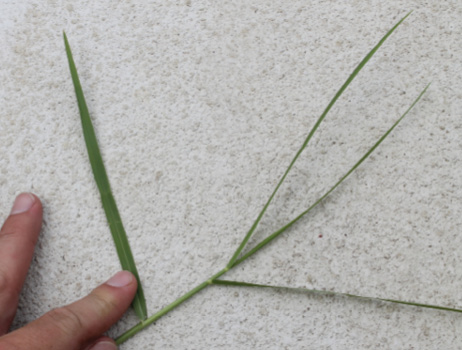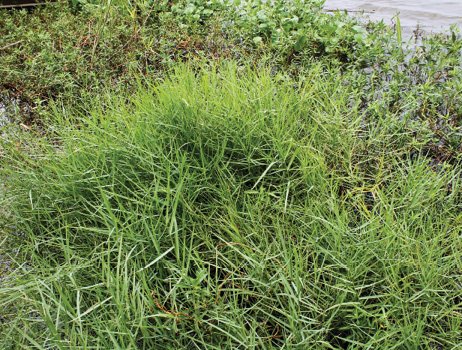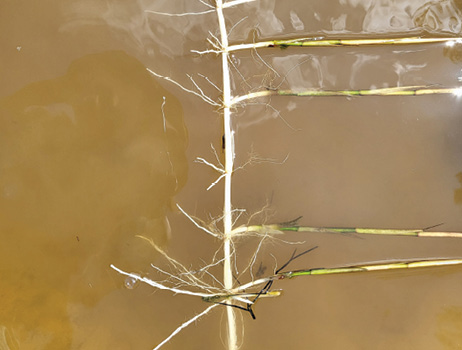Torpedograss | Panicum repens
Emergent | Non-Native



Torpedograss, which is also called panic grass, is an aggressive and difficult to control invasive grass species originally introduced from Australia. It has taken over 70 percent of Florida’s public waters and represents a significant threat to Mississippi waters.
This species grows in moist-soil and shallow-water habitats, and will quickly displace native vegetation. It can form dense mats that restrict water flow and clog intake pipes.
It has sharply pointed (torpedo-like) growing tips that can reach heights of 3 feet. The upper margins of leaves have small hairs and may have a waxy or white coating. Leaves alternate along the stem, are flat to folded and stiff, and grow at a 45-degree angle from the stem.
Torpedograss develops tremendous root/rhizome systems that are difficult to kill. Herbicides may kill the surface plant, but it can return from the root system. Repeated treatments are often required to deplete root energy reserves.
Management Value
Highly invasive and destructive. Eliminate on first detection.
Recommended Controls
The most effective herbicide for torpedograss is glyphosate.
Option 1: Glyphosate (5.4-pound formulation). For each gallon of water, mix 1.0 ounce glyphosate and 1.3 ounces non-ionic surfactant. Spray to wet all plants. Do not exceed annual herbicide rate limits as stated on the product label.
Option 2: Imazapyr (2.0-pound formulation). For each gallon of water, mix 2.0 ounces imazapyr and 1.3 ounces non-ionic surfactant. Spray to wet all plants. Do not exceed annual herbicide rate limits as stated on the product label.
Option 3: Flumioxazin (4.0-pound formulation). Flumioxazin (2.2 pints per acre-foot of water) should be applied as a submersed injection (application using a wand or hose). Determine pond volume prior to application. Use a buffering agent when mixing with water with pH greater than 7.0. Do not exceed annual herbicide rate limits as stated on the product label.
NOTE: Acre-feet = average depth of pond multiplied by pond acreage; average depth is calculated by taking the depth at 20 points across a water body and averaging the values.
Submersed injection means that the herbicide solution is applied below the water surface directly into the water. Multiple applications may be necessary to achieve eradication.
The best approach is to treat with herbicides when water temperature is at least 60˚F and the plants are actively growing. Glyphosate and imazapyr can be tank mixed and applied to torpedograss foliage. Alternating between foliar (glyphosate and/or imazapyr) and submersed (flumioxazin) herbicide treatments may enhance torpedograss control. There should be 8 weeks between each treatment.
Read and follow all chemical label instructions, especially the section on the use of personal protection equipment.
Photo Credits Bottom: Samantha Bergeron, MDWFP

The information given here is for educational purposes only. References to commercial products, trade names, or suppliers are made with the understanding that no endorsement is implied and that no discrimination against other products or suppliers is intended.
Publication 3735-34 (POD-11-23)
By Wes Neal, PhD, Extension/Research Professor, Wildlife, Fisheries, and Aquaculture; Dennis Riecke, Fisheries Coordinator, Mississippi Department of Wildlife, Fisheries, and Parks; and Gray Turnage, PhD, Assistant Research/Extension Professor, GeoSystems Research Institute.
The Mississippi State University Extension Service is working to ensure all web content is accessible to all users. If you need assistance accessing any of our content, please email the webteam or call 662-325-2262.



